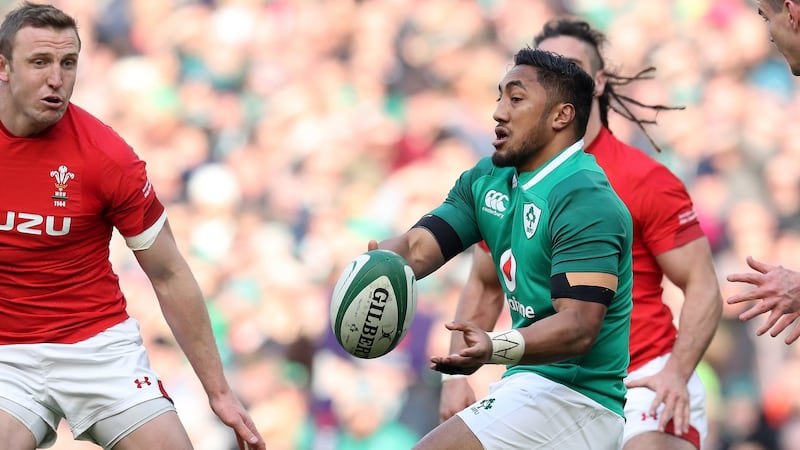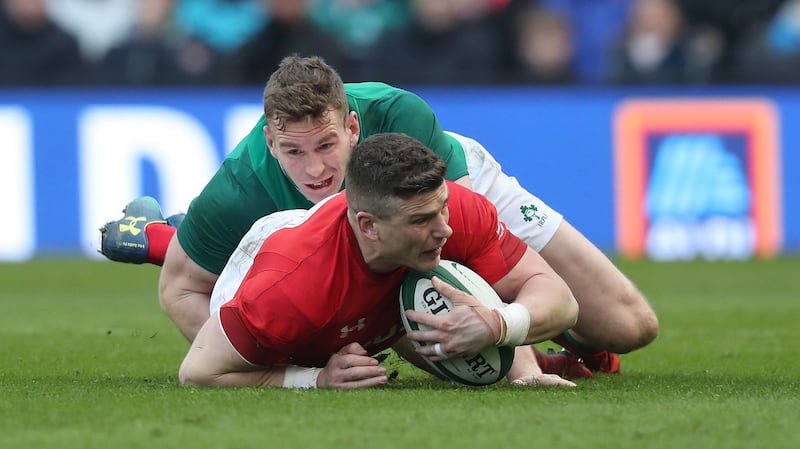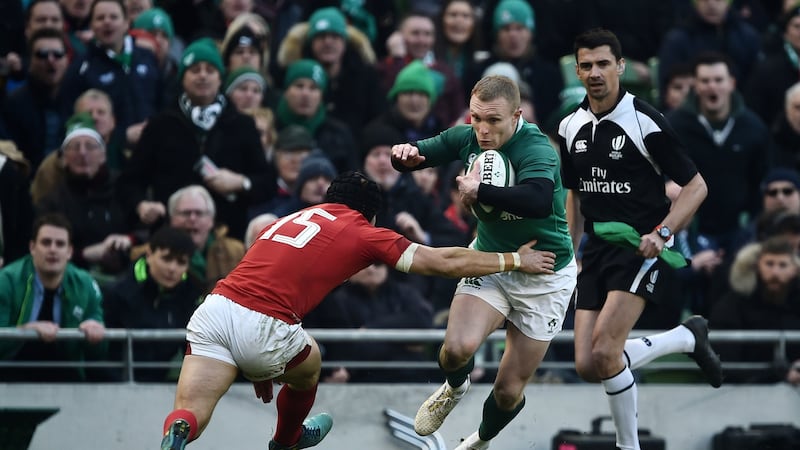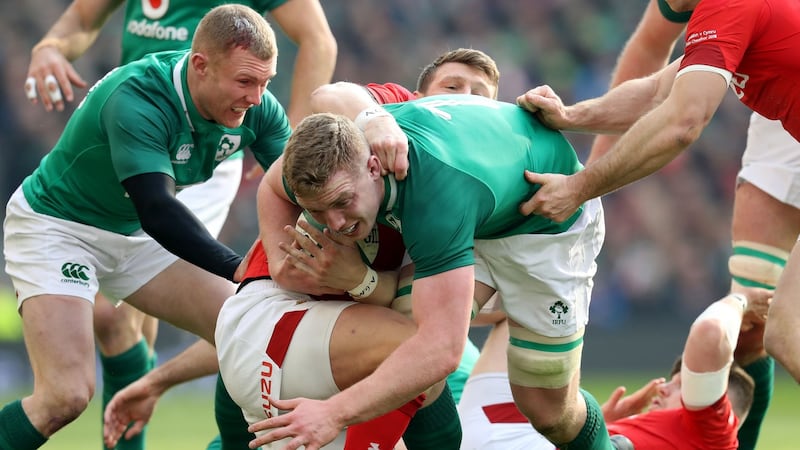There were so many things to admire in a bonus point victory over a Wales side that had filleted Scotland and been ridiculously unlucky in defeat to England. It would have been a more comfortable experience from an Irish perspective if Jonathan Sexton, who had an outstanding game in general play, had brought his kicking boots.
Scoreboard pressure has a direct impact on the ebb and flow of the game, so if Sexton had punished Welsh indiscipline then the visitors would have been squinting to the horizon to pick out a fast disappearing Ireland.
Despite the fraught denouement, there were huge positives in the performance of the pack - they bullied the Welsh for large tranches of the game - in all facets of the game and 22-year-old Andrew Porter produced a commendably high quality, mature display.
Chris Farrell produced a marvellous display, carrying, tackling and defending; his game intelligence was astonishing for someone winning his third cap. Ireland coach Joe Schmidt even used him cleverly to chase down Conor Murray's box-kicks by placing Farrell on the touchline.
Ireland scored five tries, executed a well thought out and highly effective game-plan with distinction for the most part and despite missing some hitherto key players proved that there is depth to the quality within the squad.
FOOTWORK
It’s so important in any sport and rugby is no different. The bone-on-bone collisions are unavoidable and required at times but the dividend for players who use their feet in contact can be so lucrative, a route to escaping tackles and also being able to find soft shoulders. It minimises, as much as it is possible to, the physical tariff expended but also it can allow opportunities to play the ball out of the tackle.
And close to the line, when defenders are set in a three-point stance, feet planted it can make the difference between try scoring and being thwarted. Dan Leavy offered a brilliant example in scoring his try. If he'd just put his head down and ploughed ahead, he might have been stopped but a little half-step, spin and leg drive and the ballast of his team-mates in behind allowed him to get over.

Ditto Bundee Aki for his try and it was also prevalent in virtually every carry by man-of-the-match Chris Farrell, whose intuitive ability to find the path of least resistance, was down to strength and power but also footwork. Keith Earls offers a more balletic iteration complemented by raw pace.
It's a quality that's endemic in the young players in particular, Jacob Stockdale, Farrell and Porter while it's always been part of Cian Healy's arsenal. CJ Stander's work-rate and selflessness on behalf of the team is inspirational and he takes on so much of the heavy lifting, so to speak, but he would profit from better use of his feet and also occasionally looking to sit down defenders and then pass.
DEFENCE
There were a number of issues from an Irish perspective. The primary concerns going forward are that Ireland got very narrow and when Wales kept their width and put numbers in the outside channels, they opened the home side rather easily.
The communication wasn’t what it needed to be; instead of trusting the system and adapting it to the demands from play to play, players sought a solution as individuals.
That disconnect led to a couple of soft tries that Wales didn't have to work hard for and if defence coach Andy Farrell was annoyed after Italy he'll be incandescent with both the first-up tackling and in letting the visitors get the ball to the edges without Irish players realigning correctly. There was also a lack of hustle as tired minds and legs began to power down prematurely.

Wales left wing Steff Evans spent pretty much the whole match on the touchline so the visitors had identified that Ireland had a proclivity for giving up space on the edges. Every team has to live on its wits a bit in matches when defending - it’s not chess - and there were some wonderful reads from Aki, Farrell and for Ireland’s final try and his second of the afternoon, Stockdale.
Wales’ first 13-points came from simple mistakes, a ball being stripped, hoofed up-field and then some soft defending on the fringe of a ruck along with two avoidable penalties, while later on in the game, there were tackling and spacing issues. The visitors should have had to work harder for their scores.
WHITE LINE FEVER
There were a couple of occasions when Ireland would have scored tries by simply putting the ball through the hands with numbers up out wide in the Welsh 22. Instead they opted for the pick-and-go option, which in fairness, did yield dividends in terms of three of the five tries, but a greater appreciation of what’s possible and seeking out the most expedient way to score is important as Ireland look to gain the maximum return from the blunt force trauma carrying.
That’s very effective but it’s just ensuring that the final option taken is the scoring one. It’s also an important that those players with the panoramic view of the pitch ensure that their voices are heard. Keith Earls could have taken off at one stage, flapping his arms in frustration, and it was difficult to blame him.
It was possible to throw a blanket over Ireland’s attacking formation for most of the game given how often they worked the inside channels, something that generally managed to achieve good traction in terms of go-forward ball, but what the Aki try demonstrated was the value of appreciating where the space is and how to find it.

Conor Murray could have passed to a pod of players but instead zipped a flat pass to Aki, standing just outside the massed Welsh defence - similar to his try against Italy - and allowing the centre to use his feet and strength to beat two defenders. Farrell did the same in the build-up to Stockdale's first try.
It’s about sizing up the opposition defensive line and picking the most effective point of attack, and that shouldn’t always involve shifting it to the first receiver.
It’s about heads up rather than heads down.
THE EXUBERANCE OF YOUTH
It was interesting to watch the three pals, James Ryan, Stockdale and Porter from their days together in the Ireland U-20 team stand together for the anthems pre-match and then reflect post match how much of an impact they have made in the opening stanzas of their respective careers at senior level. They are strikingly mature physically and mentally, are used to winning, and remarkable self-possessed as rugby players.
All those qualities are also evident in Leavy, another in the formative stage of his senior international career for whom there appears to be no ceiling in terms of what he can achieve as a player, so too Farrell. But it will be fun to watch.

SOME GOOD OLD ONES TOO
Healy, Devin Toner and Earls are senior in experience not years but all three produced brilliant performances.













